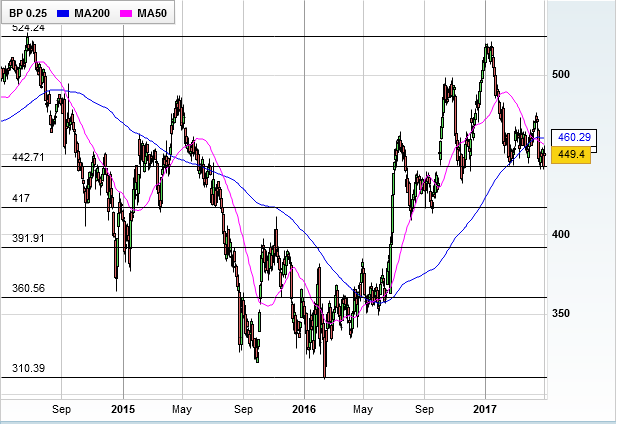Why high-yielding BP can still top 600p
2nd May 2017 13:39
by David Brenchley from interactive investor
Share on
It's all about the dividend for investors in oil major That fat 7% yield - almost double the average yield of the and miles better than what you'll get in a bank savings account - is the main allure for investors.
That's what Lydia Rainforth, an analyst at Barclays believes anyway. "It would be easy to overcomplicate the investment case for BP but, for us, the attraction is in the simplicity - if the dividend is sustainable, then the shares remain meaningfully undervalued," she says.
And that sustainability appears underpinned by BP's results for the first quarter of 2017, with the payout held steady, as expected, at 10 cents per share.
Elsewhere, they were forecast-busting numbers, with a return to quarterly profit - $1.5 billion (£1.1 billion) on an underlying replacement cost (RC) basis versus $1.2 billion expected by analysts. It was also $1.1 billion better than the previous quarter and almost three times as much as last year.
Excluding payments for the Gulf of Mexico oil spill seven years ago, operating cash flow was $4.4 billion, up almost 50% year-on-year. Include those payments and it was $2.1 billion, up from $1.9 billion.
Meanwhile, BP reported oil and gas production in the quarter was also up year-on-year, 5% higher at 3.5 million barrels of oil equivalent per day (mmboe/d).
The results nudged BP shares up 3% Tuesday to 456p, their highest in a fortnight but still 11% lower than where they started the year.

Chief executive Bob Dudley hailed a good start to the year and said its seven new major upstream projects had also started well, with a further three near completion. "We expect these to drive a material improvement in operating cash flow from the second half," he said.
Upstream numbers were a driving factor in the profits beat, raking in $1.3 billion in the period, compared to a loss of $700 million the same quarter last year thanks to higher oil prices.
These projects, which include West Nile Delta in Egypt, Quad 204 in the UK and Juniper in Trinidad, are expected to help deliver 800,000 boe/d of new production by 2020, the driller said. Projects now under construction are on average ahead of schedule and 15% below budget.
The three aforementioned projects are progressing ahead of Barclays' expectations, says Rainforth.
After a "relatively upbeat" conference call with chief financial officer Brian Gilvary, the analyst is encouraged by a material expected improvement in operating cash flow in the second half.
Back to that dividend, and Rainforth reckons investor confidence in its sustainability will increase, driven by a lower second-half charge linked to Gulf of Mexico payments, which will also become less onerous in coming years.
"It does seem to be increasingly clear that even in a flat price environment cash flow should grow quarter after quarter throughout 2017," she explained. "With these project start-ups coinciding with a lower Macondo charge in the second half the [free cash flow] numbers should improve significantly."
Clearly, BP has been boosted by the rebound in the oil price, as were US-listed rivals and after both also beat market expectations last week. Fellow high yielder is tipped to follow suit when it reports quarterly results Thursday.
But Rainforth, like many analysts, is positive on the stock and still expects the shares to break above £6, repeating her 625p price target. That implies potential upside of 37% and a recovery to levels not seen since the Deepwater Horizon oil disaster in 2010.
This article is for information and discussion purposes only and does not form a recommendation to invest or otherwise. The value of an investment may fall. The investments referred to in this article may not be suitable for all investors, and if in doubt, an investor should seek advice from a qualified investment adviser.